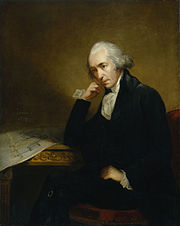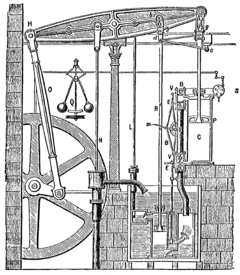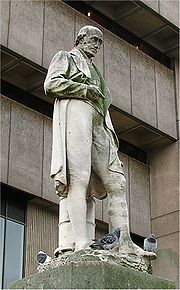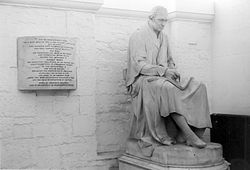
James Watt
Did you know...
SOS Children offer a complete download of this selection for schools for use on schools intranets. Sponsor a child to make a real difference.
| James Watt | |
|---|---|
 Inventor and Mechanical Engineer |
|
| Born | January 19, 1736 Greenock, Firth of Clyde, Scotland |
| Died | August 25, 1819 Handsworth, Staffordshire, England |
James Watt ( 19 January 1736 – 25 August 1819) was a Scottish inventor and mechanical engineer whose improvements to the steam engine were fundamental to the changes brought by the Industrial Revolution.
Biography
James Watt was born on 19 January, 1736 in Greenock, a seaport on the Firth of Clyde. His father was a shipwright, ship owner and contractor, while his mother, Agnes Muirhead, came from a distinguished family and was well educated. Both were Presbyterians and strong Covenanters.
Watt attended school irregularly but instead he was mostly schooled at home by his mother. He exhibited great manual dexterity and an aptitude for mathematics, although Latin and Greek left him cold, and he absorbed the legends and lore of the Scottish people.
When he was 18, his mother died and his father's health had begun to fail. Watt travelled to London to study instrument-making for a year, then returned to Scotland – to Glasgow – intent on setting up his own instrument-making business. However, because he had not served at least seven years as an apprentice, the Glasgow Guild of Hammermen (any artisans using hammers) blocked his application, despite there being no other mathematical instrument makers in Scotland.
Watt was saved from this impasse by three professors of the University of Glasgow, who offered him the opportunity to set up a small workshop within the university. It was established in 1758 and one of the professors, the physicist and chemist Joseph Black, became Watt's friend.
In 1764, Watt married his cousin Margaret Miller, with whom he had five children, two of whom lived to adulthood. She died in childbirth in 1772. In 1777 he married again, to Ann MacGregor, daughter of a Glasgow dye-maker, who survived him. She died in 1832.
Watt had a brother by the name of John. He was shipwrecked when James was 17.
Four years after opening his shop, Watt began to experiment with steam after his friend, Professor John Robison, called his attention to it. At this point Watt had still never seen an operating steam engine, but he tried constructing a model. It failed to work satisfactorily, but he continued his experiments and began to read everything about it he could. He independently discovered the importance of latent heat in understanding the engine, which, unknown to him, Black had famously discovered some years before. He learned that the University owned a model Newcomen engine, but it was in London for repairs. Watt got the university to have it returned, and he made the repairs in 1763. It too just barely worked, and after much experimentation he showed that about 80% of the heat of the steam was consumed in heating the cylinder, because the steam in it was condensed by an injected stream of cold water. His critical insight, to cause the steam to condense in a separate chamber apart from the piston, and to maintain the temperature of the cylinder at the same temperature as the injected steam, came finally in 1765 and he soon had a working model.
Now came a long struggle to produce a full-scale engine. This required more capital, some of which came from Black. More substantial backing came from John Roebuck, the founder of the celebrated Carron Iron Works, near Falkirk, with whom he now formed a partnership. But the principal difficulty was in machining the piston and cylinder. Iron workers of the day were more like blacksmiths than machinists, so the results left much to be desired. Much capital was spent in pursuing the ground-breaking patent, which in those days required an act of parliament. Strapped for resources, Watt was forced to take up employment as a surveyor for eight years. Roebuck went bankrupt, and Matthew Boulton, who owned the Soho foundry works near Birmingham, acquired his patent rights. Watt and Boulton formed a hugely successful partnership ( Boulton & Watt), which lasted for the next twenty-five years.
Watt finally had access to some of the best iron workers in the world. The difficulty of the manufacture of a large cylinder with a tightly fitting piston was solved by John Wilkinson who had developed precision boring techniques for cannon making at Bersham, near Wrexham, North Wales. Finally, in 1776, the first engines were installed and working in commercial enterprises. These first engines were used for pumps and produced only reciprocating motion. Orders began to pour in and for the next five years Watt was very busy installing more engines, mostly in Cornwall for pumping water out of mines.
The field of application of the invention was greatly widened only after Boulton urged Watt to convert the reciprocating motion of the piston to produce rotational power for grinding, weaving and milling. Although a crank seemed the logical and obvious solution to the conversion Watt and Boulton were stymied by a patent for this, whose holder, James Pickard, and associates proposed to cross-license the external condensor. Watt adamantly opposed this and they circumvented the patent by their sun and planet gear in 1781.
Over the next six years, he made a number of other improvements and modifications to the steam engine. A double acting engine, in which the steam acted alternately on the two sides of the piston was one. A throttle valve to control the power of the engine, and a centrifugal governor to keep it from "running away" were very important. He described methods for working the steam expansively. A compound engine, which connected two or more engines was described. Two more patents were granted for these in 1781 and 1782. Numerous other improvements that made for easier manufacture and installation were continually implemented. One of these included the use of the steam indicator which produced an informative plot of the pressure in the cylinder against its volume, which he kept as a trade secret. Another important invention, one of which Watt was most proud of, was the Parallel motion / three-bar linkage which was especially important in double-acting engines as it produced the straight line motion required for the cylinder rod and pump, from the connected rocking beam, whose end moves in a circular arc. This was patented in 1784. These improvements taken together produced an engine which was up to five times as efficient in its use of fuel as the Newcomen engine.
Because of the danger of exploding boilers and the ongoing issues with leaks, Watt was opposed from the first to the use of high pressure steam--all of his engines used steam at very low pressure.
In 1794 the partners established Boulton and Watt to exclusively manufacture steam engines, and this became a large enterprise. By 1824 it had produced 1164 steam engines having a total nominal horsepower of about 26,000. Boulton proved to be an excellent businessman, and both men eventually made fortunes.
Method and personality
Watt was an enthusiastic inventor, with a fertile imagination that sometimes got in the way of finishing his works, because he could always see "just one more improvement." He was skilled with his hands, and was also able to perform systematic scientific measurements that could quantify the improvements he made and produce a greater understanding of the phenomenon he was working with.
Watt was a gentleman, greatly respected by other prominent men of the Industrial Revolution. He was an important member of the Lunar Society, and was a much sought after conversationalist and companion, always interested in expanding his horizons. He was a rather poor businessman, and especially hated bargaining and negotiating terms with those who sought to utilize the steam engine. Until he retired, he was always much concerned about his financial affairs, and was something of a worrier. His personal relationships with his friends and partners were always congenial and long-lasting.
Later years
Watt retired in 1800, the same year that his fundamental patent and partnership with Boulton expired. The famous partnership was transferred to the men's sons, Matthew Boulton and James Watt Jr. Longtime firm engineer William Murdoch was made a partner and the firm prospered.
Watt continued to invent other things before and during his semi-retirement. He invented a new method of measuring distances by telescope, a device for copying letters, improvements in the oil lamp, a steam mangle and a machine for copying sculptures.
He and his second wife travelled to France and Germany, and he purchased an estate in Wales at Doldowlod House, one mile south of Llanwrthwl, which he much improved.
He died on 25 August 1819 at his home "Heathfield" in Handsworth, Staffordshire, England at the age of 83. He was buried on 2 September.
Controversy
As with many major inventions, there is some dispute as to whether Watt was the original sole inventor of some of the numerous inventions he patented. There is no dispute, however, that he was the sole inventor of his most important invention, the separate condenser. It was his practice (from around the 1780s) to pre-empt others' ideas which were known to him by filing patents with the intention of securing credit for the invention for himself, and ensuring that no one else was able to practice it. As he states in a letter to Boulton of 17 August 1784:
- "I have given such descriptions of engines for wheel carriages as I could do in the time and space I could allow myself; but it is very defective and can only serve to keep other people from similar patents".
Some argue that his prohibitions on his employee William Murdoch from working with high pressure steam on his steam road locomotive experiments delayed its development. Watt, with his partner Matthew Boulton, battled against rival engineers such as Jonathan Hornblower who tried to develop engines which did not fall foul of his patents.
Watt patented the application of the sun and planet gear to steam in 1781 and a steam locomotive in 1784, both of which have strong claims to have been invented by his employee, William Murdoch. Watt himself described the provenance of the invention of the sun and planet gear in a letter to Boulton from Watt dated January 5 1782:
- "I have tried a model of one of my old plans of rotative engines revived and executed by W. M[urdock] and which merits being included in the specification as a fifth method..."
The patent was never contested by Murdoch, who remained an employee of Boulton and Watt for most of his life, and Boulton and Watt's firm continued to use the sun and planet gear in their rotative engines, even long after the patent for the crank expired in 1794.
Legacy
James Watt's improvements to the steam engine transformed the Newcomen engine, which had hardly changed for fifty years, and initiated a series of improvements in generating and applying power, which transformed the world of work, and was a key innovation of the Industrial Revolution. The importance of the invention can hardly be overstated--it gave us the modern world. A key feature of it was that it brought the engine out of the remote coal fields into factories where many mechanics, engineers, and even tinkerers were exposed to its virtues and limitations. It was a platform for generations of inventors to improve. It was clear to many that higher pressures produced in improved boilers would produce engines having even higher efficiency, and would lead to the revolution in transportation that was soon embodied in the locomotive and steamboat. It made possible the construction of new factories that, since they were not dependent on water power, could work the year round, and could be placed almost anywhere. Work was moved out of the cottages, resulting in economies of scale. Capital could work more efficiently, and manufacturing productivity greatly improved. It made possible the cascade of new sorts of machine tools that could be used to produce better machines, including that most remarkable of all of them, the Watt steam engine.
Of Watt, the English Novelist Aldous Huxley (1894-1963) wrote; "To us, the moment 8:17 A.M. means something - something very important, if it happens to be the starting time of our daily train. To our ancestors, such an odd eccentric instant was without significance - did not even exist. In inventing the locomotive, Watt and Stephenson were part inventors of time."
Honours
Watt was a fellow of the Royal Society of Edinburgh and the Royal Society of London. He was a member of the Batavian Society, and one of only eight Foreign Associates of the French Academy of Sciences.
The watt is named after James Watt for his contributions to the development of the steam engine, and was adopted by the Second Congress of the British Association for the Advancement of Science in 1889 and by the 11th General Conference on Weights and Measures in 1960 as the unit of power incorporated in the International System of Units (or "SI"). This SI unit is named after James Watt. As with every International System of Units (SI) unit whose name is derived from the proper name of a person, the first letter of its symbol is upper case (W). However, when an SI unit is spelled out in English, it should always begin with a lower case letter (watt), except in a situation where any word in that position would be capitalized, such as at the beginning of a sentence or in capitalized material such as a title. Note that "degree Celsius" conforms to this rule because the "d" is lowercase. —Based on The International System of Units, section 5.2.
Memorials
Watt was buried in the grounds of St. Mary's Church, Handsworth, in Birmingham. Later expansion of the church, over his grave, means that his tomb is now buried inside the church. A statue of him, Boulton and Murdoch is in Birmingham, as are two other statues of him alone, one in Chamberlain Square, the other outside the Law Courts. He is also remembered by the Moonstones and a school is named in his honour, both in Birmingham. An extensive archive of his papers is held at Birmingham Central Library. Matthew Boulton's home, Soho House, is now a museum, commemorating the work of both men. The University of Glasgow's Faculty of Engineering, the oldest in the United Kingdom, (where Watt was a professor) has its headquarters in the James Watt Building, which also houses the department of Mechanical Engineering and the department of Aerospace Engineering.
The location of James Watt's birth in Greenock is commemorated by a statue, close to his birthplace. Several locations and street names in Greenock recall him, most notably the Watt Memorial Library, which was begun in 1816 with Watt's donation of scientific books, and developed as part of the Watt Institution by his son (which ultimately became the James Watt College). Taken over by the local authority in 1974, the library now also houses the local history collection and archives of Inverclyde, and is dominated by a large seated statue in the vestibule. Watt is additionally commemorated by statuary in George Square, Glasgow and Princes Street, Edinburgh.
The James Watt College has expanded from its original location to include campuses in Kilwinning (North Ayrshire), Finnart Street and The Waterfront in Greenock, and the Sports campus in Largs. The Heriot-Watt University near Edinburgh was at one time the "Watt Institution and School of Arts" named in his memory, then merged with George Heriot's Hospital for needy orphans and the name was changed to Heriot-Watt College. Dozens of university and college buildings (chiefly of science and technology) are named after him.
The huge painting James Watt contemplating the steam engine by James Eckford Lauder is now owned by the National Gallery of Scotland.
Watt was ranked first, tying with Edison, among 229 significant figures in the history of technology by Charles Murray's survey of historiometry presented in his book Human Accomplishments. Watt was ranked 22nd in Michael H. Hart's list of the most influential figures in history.
Over 50 roads or streets in the UK are named after him.
A colossal statue of Watt by Chantrey was placed in Westminster Abbey, and later was moved to St. Paul's Cathedral. On the cenotaph the inscription reads:
- NOT TO PERPETUATE A NAME,
- WHICH MUST ENDURE WHILE THE PEACEFUL ARTS FLOURISH,
- BUT TO SHOW
- THAT MANKIND HAVE LEARNED TO HONOUR THOSE
- WHO BEST DESERVE THEIR GRATITUDE,
- THE KING,
- HIS MINISTERS, AND MANY OF THE NOBLES
- AND COMMONERS OF THE REALM
- RAISED THIS MONUMENT TO
- JAMES WATT
- WHO DIRECTING THE FORCE OF AN ORIGINAL GENIUS
- EARLY EXERCISED IN PHILOSOPHIC RESEARCH
- TO THE IMPROVEMENT OF
- THE STEAM-ENGINE
- ENLARGED THE RESOURCES OF HIS COUNTRY
- INCREASED THE POWER OF MAN
- AND ROSE TO AN EMINENT PLACE
- AMONG THE MOST ILLUSTRIOUS FOLLOWERS OF SCIENCE
- AND THE REAL BENEFACTORS OF THE WORLD
- BORN AT GREENOCK MDCCXXXVI
- DIED AT HEATHFIELD IN STAFFORDSHIRE MDCCCXIX
A lecture theatre in the Mechanical & Manufacturing Engineering building at the University of Birmingham is named 'G31 - The James Watt Lecture Theatre'



